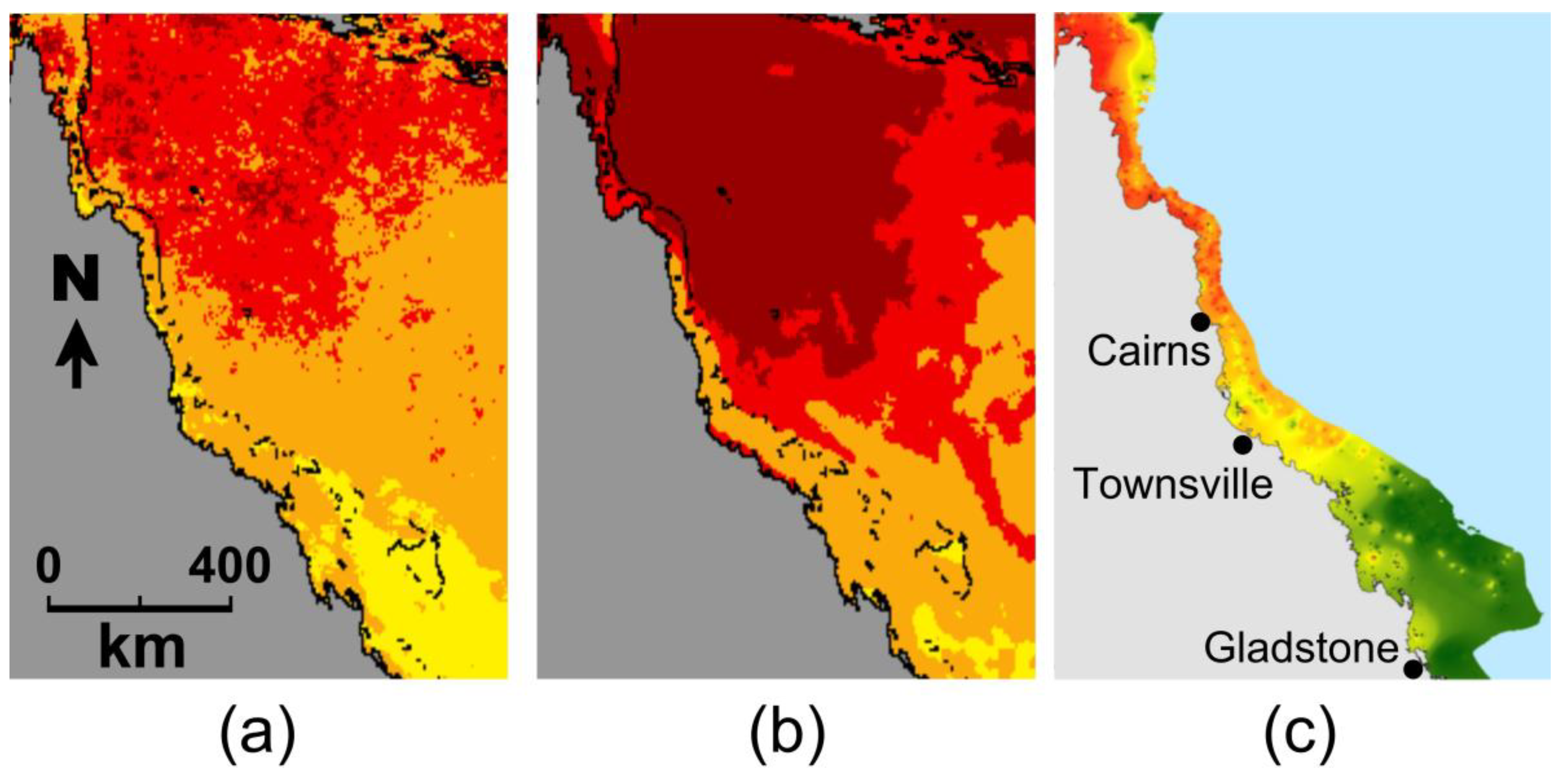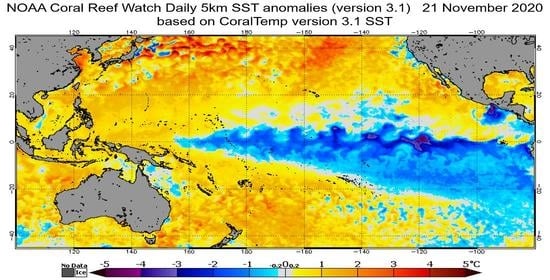CoralTemp and the Coral Reef Watch Coral Bleaching Heat Stress Product Suite Version 3.1
Abstract
:1. Introduction
2. Data and Methods
2.1. CoralTemp Version 3.1
- The Operational SST and Sea Ice Analysis (OSTIA) reanalysis version 1.0 [8] combines polar-orbiting satellite SST with in situ data from the International Comprehensive Ocean-Atmosphere Data Set (ICOADS) to produce a daily, gap-free SST product, gridded at 0.05 degrees, that spans 1985 to 2007. The OSTIA reanalysis includes SST data from thermal infrared sensors on nine polar-orbiting satellites, information about the presence of ice from microwave sensors on two polar-orbiting satellites, and all of the in situ data contained within the ICOADS Release 2.0 dataset (Figure 1);
- The NOAA Geo-Polar SST product is an operational NRT SST product, developed and delivered by NOAA [4]. The Geo-Polar SST product combines SST from a combination of two, and more recently three, polar orbiting satellites and now five geostationary satellites. The NRT Geo-Polar SST now uses NRT OSTIA as a bias correction reference, rather than the NOAA National Centers for Environmental Prediction (NCEP) Real-Time Global High-Resolution SST. As with OSTIA, the NRT Geo-Polar SST product is a daily, gap-free SST product, gridded at 0.05 degrees;
- The NOAA Geo-Polar SST reanalysis product implements the same methodologies as the NRT Geo-Polar SST, and also uses OSTIA to correct for bias (the OSTIA reanalysis is used from 2002 to end-2007 and the NRT OSTIA is used from 2008 to 2016). Throughout the entire reprocessing period (2002 to 2016), SSTs from two polar orbiting satellites and 2–4 geostationary satellites were used as data inputs. As with the OSTIA and NRT Geo-Polar SST, the Geo-Polar SST reanalysis product is a daily, gap-free SST product, gridded at 0.05 degrees.
- Day 1: (28 × SSTOSTIA + 1 × SSTGP)/29
- Day 2: (27 × SSTOSTIA + 2 × SSTGP)/29
- … through to
- Day 28: (1 × SSTOSTIA + 28 × SSTGP)/29, where GP is short for Geo-Polar SST.
2.2. Monthly Mean Climatology
2.3. Maximum Monthly Mean Climatology
2.4. SST Anomaly Product
2.5. Coral Bleaching HotSpot (HS) Product
2.6. Degree Heating Week (DHW) Product
3. Discussion
3.1. CoralTemp
3.2. MM and MMM Climatologies
3.3. SST Anomaly Product
3.4. Coral Bleaching HotSpot Product
3.5. Degree Heating Week Product
4. Conclusions
Author Contributions
Funding
Acknowledgments
Conflicts of Interest
References
- Eakin, C.M.; Morgan, J.A.; Heron, S.F.; Smith, T.B.; Liu, G.; Alvarez-Filip, L.; Baca, B.; Bartels, E.; Bastidas, C.; Bouchon, C.; et al. Caribbean Corals in Crisis: Record Thermal Stress, Bleaching, and Mortality in 2005. PLoS ONE 2010, 5, e13969. [Google Scholar] [CrossRef] [PubMed] [Green Version]
- Heron, S.F.; Johnston, L.; Liu, G.; Geiger, E.F.; Maynard, J.A.; De La Cour, J.L.; Johnson, S.; Okano, R.; Benavente, D.; Burgess, T.F.R.; et al. Validation of Reef-Scale Thermal Stress Satellite Products for Coral Bleaching Monitoring. Remote Sens. 2016, 8, 59. [Google Scholar] [CrossRef] [Green Version]
- Skirving, W.J.; Heron, S.F.; Marsh, B.L.; Liu, G.; De La Cour, J.L.; Geiger, E.F.; Eakin, C.M. The relentless march of mass coral bleaching: A global perspective of changing heat stress. Coral Reefs 2019, 38, 547–557. [Google Scholar] [CrossRef] [Green Version]
- Maturi, E.; Harris, A.; Mittaz, J.; Sapper, J.; Wick, G.; Zhu, X.; Dash, P.; Koner, P.K. A New High-Resolution Sea Surface Temperature Blended Analysis. Bull. Am. Meteorol. Soc. 2017, 98, 1015–1026. [Google Scholar] [CrossRef]
- Liu, G.; Heron, S.F.; Eakin, C.M.; Mullerkarger, F.E.; Vega-Rodriguez, M.; Guild, L.S.; De La Cour, J.L.; Geiger, E.F.; Skirving, W.J.; Burgess, T.F.R.; et al. Reef-Scale Thermal Stress Monitoring of Coral Ecosystems: New 5-km Global Products from NOAA Coral Reef Watch. Remote Sens. 2014, 6, 11579–11606. [Google Scholar] [CrossRef] [Green Version]
- Heron, S.F.; Liu, G.; Rauenzahn, J.L.; Christensen, T.R.L.; Skirving, W.J.; Burgess, T.F.R.; Eakin, C.M.; Morgan, J.A. Improvements to and continuity of operational global thermal stress monitoring for coral bleaching. J. Oper. Oceanogr. 2014, 7, 3–11. [Google Scholar] [CrossRef]
- Liu, G.; Skirving, W.J.; Geiger, E.F.; De La Cour, J.L.; Marsh, B.L.; Heron, S.F.; Tirak, K.V.; Strong, A.E.; Eakin, C.M. NOAA Coral Reef Watch’s 5km satellite coral bleaching heat stress monitoring product suite version 3 and four-month Outlook version 4. Reef Encount. 2017, 32, 39–45. [Google Scholar]
- Roberts-Jones, J.; Fiedler, E.K.; Martin, M.J. Daily, Global, High-Resolution SST and Sea Ice Reanalysis for 1985–2007 Using the OSTIA System. J. Clim. 2012, 25, 6215–6232. [Google Scholar] [CrossRef]
- Glynn, P.W.; D’Croz, L. Experimental evidence for high temperature stress as the cause of El Niño-coincident coral mortality. Coral Reefs 1990, 8, 181–191. [Google Scholar] [CrossRef]
- Jokiel, P.L.; Coles, S.L. Response of Hawaiian and other Indo-Pacific reef corals to elevated temperature. Coral Reefs 1990, 8, 155–162. [Google Scholar] [CrossRef]
- Hoegh-Guldberg, O. Climate change, coral bleaching and the future of the world’s coral reefs. Mar. Freshw. Res. 1999, 50, 839–866. [Google Scholar] [CrossRef] [Green Version]
- Ove, H.-G.; Hoegh-Guldberg, O. The cell physiology of coral bleaching. In Tropical Mangrove Ecosystems; Phinney, J.T., Hoegh-Guldberg, O., Kleypas, J., Skirving, W., Strong, A., Eds.; American Geophysical Union: Washington, DC, USA, 2006; pp. 55–71. [Google Scholar]
- Donlon, C.; Martin, M.; Stark, J.D.; Roberts-Jones, J.; Fiedler, E.; Wimmer, W. The Operational Sea Surface Temperature and Sea Ice Analysis (OSTIA) system. Remote Sens. Environ. 2012, 116, 140–158. [Google Scholar] [CrossRef]
- Fiedler, E.K.; McLaren, A.; Banzon, V.; Brasnett, B.; Ishizaki, S.; Kennedy, J.; Rayner, N.; Roberts-Jones, J.; Corlett, G.; Merchant, C.J.; et al. Intercomparison of long-term sea surface temperature analyses using the GHRSST Multi-Product Ensemble (GMPE) system. Remote Sens. Environ. 2019, 222, 18–33. [Google Scholar] [CrossRef] [Green Version]
- Thiébaux, J.; Rogers, E.; Wang, W.; Katz, B. A New High-Resolution Blended Real-Time Global Sea Surface Temperature Analysis. Bull. Am. Meteorol. Soc. 2003, 84, 645–656. [Google Scholar] [CrossRef] [Green Version]
- Strong, A.; Barrientos, C.S.; Duda, C.; Sapper, J. Improved Satellite Techniques for Monitoring Coral Reef Bleaching. In Proceedings of the 8th International Coral Reef Symposium, Panama City, Panama, 24–29 June 1996; Volume 2, pp. 1495–1498. [Google Scholar]
- Skirving, W.J.; Liu, G.; Strong, A.E.; Liu, C.; Sapper, J.; Arzayus, F. Extreme events and perturbations of coastal ecosystems. In Thermal Infrared Remote Sensing; Rixhardson, L., LeDrew, E., Eds.; Springer: Dordrecht, The Netherlands, 2006; Volume 9, pp. 11–25. [Google Scholar]
- Skirving, W.J.; Enríquez, S.; Hedley, J.D.; Ove, H.-G.; Eakin, C.M.; Mason, R.A.B.; De La Cour, J.L.; Liu, G.; Hoegh-Guldberg, O.; Strong, A.E.; et al. Remote Sensing of Coral Bleaching Using Temperature and Light: Progress towards an Operational Algorithm. Remote Sens. 2017, 10, 18. [Google Scholar] [CrossRef] [Green Version]
- Mason, R.A.B.; Skirving, W.J.; Ove, H.-G. Integrating physiology with remote sensing to advance the prediction of coral bleaching events. Remote Sens. Environ. 2020, 246, 111794. [Google Scholar] [CrossRef]
- Hughes, D.P.M.; Kerry, J.T.; Baird, A.H.; Connolly, S.R.; Dietzel, A.; Eakin, C.M.; Heron, S.F.; Hoey, A.S.; Hoogenboom, M.O.; Liu, G.; et al. Global warming transforms coral reef assemblages. Nat. Cell Biol. 2018, 556, 492–496. [Google Scholar] [CrossRef] [PubMed]
- Marshall, P.; Schuttenberg, H. A Reef Manager’s Guide to Coral Bleaching; Great Barrier Reef Marine Park Authority: Townsville, Australia, 2006; p. 164.
- Thomas, C.R.; Heron, S.F. South-East Asia Coral Bleaching Rapid Response: Final Report; Commonwealth Scientific and Industrial Research Organisation: Campbell, Australia, 2011; p. 24.
- Moore, J.A.Y.; Bellchambers, L.M.; Depczynski, M.; Evans, R.D.; Evans, S.N.; Field, S.N.; Friedman, K.J.; Gilmour, J.P.; Holmes, T.H.; Middlebrook, R.; et al. Unprecedented Mass Bleaching and Loss of Coral across 12° of Latitude in Western Australia in 2010–11. PLoS ONE 2012, 7, e51807. [Google Scholar] [CrossRef] [PubMed] [Green Version]
- Liu, G.; Eakin, C.M.; Rauenzahn, J.L.; Christensen, T.R.L.; Heron, S.F.; Li, J.; Skirving, W.; Strong, A.E.; Burges, T. NOAA Coral Reef Watch’s Decision Support System for Coral Reef Management. In Proceedings of the 12th International Coral Reef Symposium, Cairns, Australia, 9–13 July 2012; p. 5. [Google Scholar]
- GBRMPA. Coral Bleaching Risk and Impact Assessment Plan, 2nd ed.; Great Barrier Reef Marine Park Authority: Townsville, Australia, 2013; ISSN 2200-2022.
- Hughes, D.P.M.; Kerry, J.T.; Álvarez-Noriega, M.; Álvarez-Romero, J.G.; Anderson, K.D.; Baird, A.H.; Babcock, R.C.; Beger, M.; Bellwood, D.R.; Berkelmans, R.; et al. Global warming and recurrent mass bleaching of corals. Nat. Cell Biol. 2017, 543, 373–377. [Google Scholar] [CrossRef] [PubMed]




Publisher’s Note: MDPI stays neutral with regard to jurisdictional claims in published maps and institutional affiliations. |
© 2020 by the authors. Licensee MDPI, Basel, Switzerland. This article is an open access article distributed under the terms and conditions of the Creative Commons Attribution (CC BY) license (http://creativecommons.org/licenses/by/4.0/).
Share and Cite
Skirving, W.; Marsh, B.; De La Cour, J.; Liu, G.; Harris, A.; Maturi, E.; Geiger, E.; Eakin, C.M. CoralTemp and the Coral Reef Watch Coral Bleaching Heat Stress Product Suite Version 3.1. Remote Sens. 2020, 12, 3856. https://doi.org/10.3390/rs12233856
Skirving W, Marsh B, De La Cour J, Liu G, Harris A, Maturi E, Geiger E, Eakin CM. CoralTemp and the Coral Reef Watch Coral Bleaching Heat Stress Product Suite Version 3.1. Remote Sensing. 2020; 12(23):3856. https://doi.org/10.3390/rs12233856
Chicago/Turabian StyleSkirving, William, Benjamin Marsh, Jacqueline De La Cour, Gang Liu, Andy Harris, Eileen Maturi, Erick Geiger, and C. Mark Eakin. 2020. "CoralTemp and the Coral Reef Watch Coral Bleaching Heat Stress Product Suite Version 3.1" Remote Sensing 12, no. 23: 3856. https://doi.org/10.3390/rs12233856
APA StyleSkirving, W., Marsh, B., De La Cour, J., Liu, G., Harris, A., Maturi, E., Geiger, E., & Eakin, C. M. (2020). CoralTemp and the Coral Reef Watch Coral Bleaching Heat Stress Product Suite Version 3.1. Remote Sensing, 12(23), 3856. https://doi.org/10.3390/rs12233856






